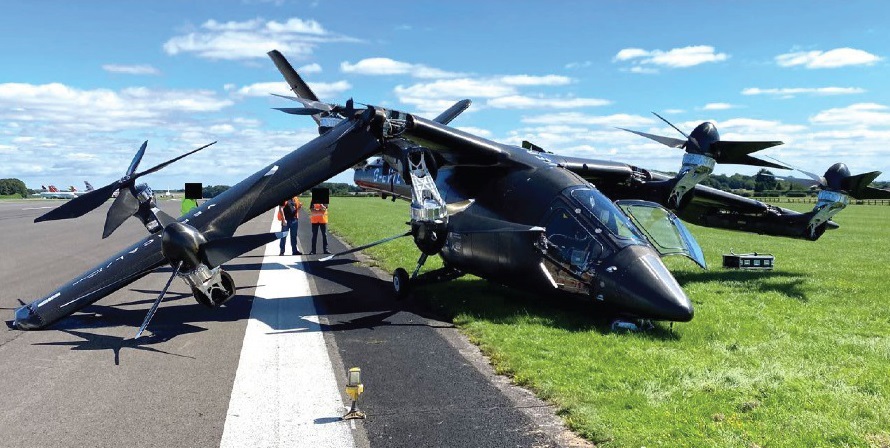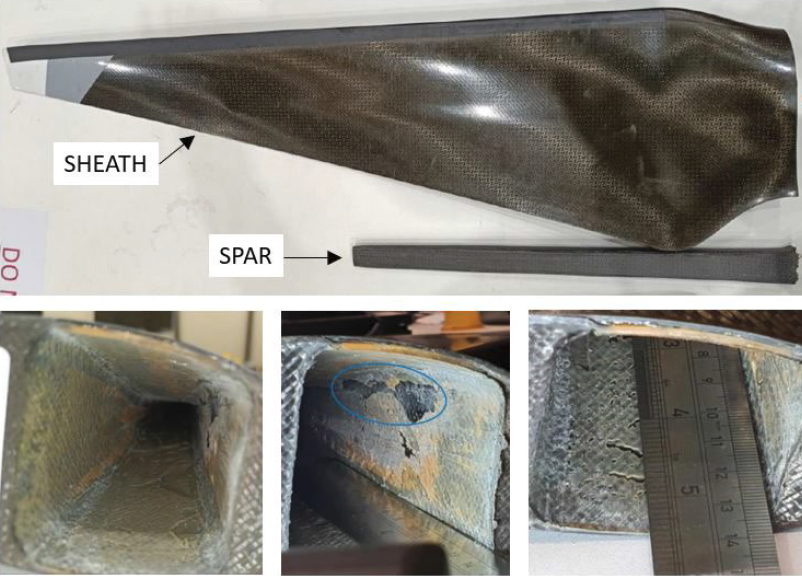


Probably, one of the very first reports on an eVTOL accidents by an Aviation regulator, a report has been published by the UK Air Accidents Investigation Branch (AAIB) into the accident involving an VA-1X (G-EVTL), which suffered a forced landing following power unit failure,Cotswold Airport (Kemble), Gloucestershire, 9 August 2023.
The G-EVTL is an Electric Vertical Takeoff and Landing (eVTOL) prototype with a carbon fibre composite structure, fixed tricycle landing gear, V-tail and a high wing. In its configuration for this test the aircraft had a maximum takeoff mass of 3,737 kg and could be flown with a pilot onboard or remotely.
The aircraft is powered by eight electric propulsion units (EPUs), each driving a propeller, with four on the wing leading edge and four on the trailing edge. The forward EPUs are numbered 1 to 4, from left to right, and the rear EPUs are numbered 5 to 8, also from left to right.
It was an uncrewed flight, the Vertical Aerospace eVTOL was being flown by a remote pilot on a test flight at 30 ft agl when a propeller blade detached from the electric propulsion unit 3 forward motor due to a failure of the adhesive bond between the propeller blade sheath and spar.
Subsequently, large out-of-balance loads generated by the blade release caused structural failure of the right inboard pylon, resulting in damage to the aircraft’s wiring harnesses. This caused a loss of thrust from motors 4 and 7.
Whilst the aircraft’s flight control system was able to maintain a level attitude, the high rate of descent caused by the loss of vertical thrust resulted in substantial damage to the aircraft when it struck the ground.
As per AAIB , the G-EVTL eVTOL was in the second phase of its test flying having completed the initial tethered phase. The accident flight was the twenty-second flight of the programme.
The aim of the test was to look at one engine inoperative performance during out of ground effect hover. The aircraft was being flown remotely under the CAA Specific Category.

The aircraft hit the southern edge of Runway 26 in a level attitude with the right mainwheel on the paved runway surface and the left mainwheel and nosewheel on the grass.
The right wing had broken at the inboard pylon but remained attached to the aircraft by wiring harnesses. Two propeller blades had detached from EPU3, with the blade sheath that separated in flight coming to rest 50 m from the aircraft, at its seven o’clock position.
A section of blade spar that had also released came to rest close to where the sheath had landed. A second blade had detached during the ground impact as EPU3’s propeller was still rotating when the aircraft touched down.
Aircraft examination Pylon 3 had failed in overload due to high out-of-balance loads caused when the EPU3 propeller blade released, allowing the forward section of the pylon to initially rotate vertically upwards under residual propeller thrust.
This movement damaged the wiring harnesses where pylon 3 was attached to the wing front spar, severing the CAN bus C1 and C2 wiring. Low voltage wires providing power and return feeds to the EPU3 inverter were open circuit within a connector, due to cable strain.
The nose landing gear had collapsed and the left main landing gear oleo remained fully compressed. A number of skin-to-frame fasteners had pulled through the fuselage skin around the right main landing gear upper fitting.
The right wing had failed in downward bending overload at the inboard pylon station. The blade sheath that released during flight showed evidence of poor bonding between the sheath and the blade spar.
The failure of the adhesive bond between the EPU3 propeller blade sheath and spar allowed the sheath to translate radially outwards, increasing the bending load on the blade spar which caused the outer section of the spar to fracture and separate.
The loss of the blade whilst the propeller was spinning at 1,200 rpm generated large out-of-balance forces, causing the structural failure of the forward section of pylon 3.
The upward rotation of the broken section of pylon 3, due to the remaining thrust from EPU3 whilst its propeller continued to rotate, damaged the aircraft’s wiring harnesses. This resulted in the loss of thrust from EPU4 and EPU7.
With the remaining vertical thrust insufficient to sustain the aircraft in a hover, it descended vertically whilst the flight control system retained a level pitch and roll attitude. The aircraft struck the ground at a rate of descent approximately twice the limit descent velocity that it was designed to withstand, leading to structural damage to the right wing, landing gear and fuselage.
The released propeller blade was operating within its normal rpm and loading levels when it detached, without any increased vibration or foreign object impact prior to release.
The blade sheath detached due to failure of the adhesive bond between the blade sheath and spar.
Stress analysis performed by the manufacturer showed that only 5% of the spar to-sheath bond area was required to retain the sheath at the centrifugal loading condition when the bond failed.
It is therefore likely that progressive degradation of the bond occurred during operation prior to the blade release.

As per AAIB report, the manufacturer has identified the propeller blade’s structural design, the manufacturing controls, quality assurance processes and verification programme as contributory factors.
Source : Adapted from the AAIB-29460 / Pictures : Crown copyright 2024
